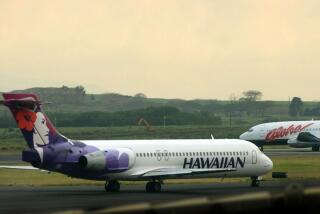Convenience Is Sometimes Foreign on Vessels
- Share via
Here’s a problem: If you live in San Diego and want to take a midweek cruise aboard the Azure Seas or the Southward, you can’t just hop aboard the ships when they call in San Diego, no matter how convenient that might be.
Instead, you will have to travel from San Diego to San Pedro’s Port of Los Angeles and embark the ships there with the rest of the passengers.
If you also have been thinking about sailing to Hawaii this winter with Royal Cruise Line or Holland America Line, you’ll have to board a motor coach in San Diego and be driven to Ensenada, Mexico, to board your ship.
Princess Cruises can take you to Hawaii, too, but only if you get on or off the ship in Vancouver, Canada, or Tahiti.
In addition, if you’ve booked an Alaska cruise with Princess or Holland America, the two largest lines sailing there, you’ll probably begin or end your cruise in Vancouver, even though you may have arrived there by motor coach from the Seattle-Tacoma Airport.
What’s going on here?
In 1886, American legislators came up with the Passenger Service Act, which forbids foreign-flag vessels from picking up passengers in one U.S. port and dropping them off in another without calling at a foreign port in between.
(Although the Passenger Service Act is often incorrectly referred to as the Jones Act, the latter is actually a similar set of laws protecting U.S. cabotage, or coastal cargo shipping.)
While numerous efforts have been made over the years to repeal or amend the Passenger Service Act, U.S. labor unions and cargo ship owners, fearful that any changes could undermine the act itself, have been successful in quashing them.
At present, there are only two large ocean-going, U.S.-flag cruise ships--American Hawaii Cruises’ Constitution and Independence, each carrying about 775 passengers. Both are based in Honolulu for seven-day cruises around the islands.
The other major U.S.-flag companies are Clipper Cruises, which operates two small ships in and around North, Central and South America; the Delta Queen Steamboat Co., with two paddle-wheel steamers on the Mississippi River and its tributaries, and American Canadian Caribbean Line, which runs two small ships in the Caribbean in winter, then Canada and the Northeast United States in summer.
For a ship to qualify as “U.S.-flag,” it must have been built and registered in the United States, be staffed by a predominantly American crew, and must never have been re-flagged to another country.
An exception was made in the case of American Hawaii’s Independence, where a special bill enacted by Congress in 1979 allowed the decommissioned vessel--then under Panamanian registry--to regain its U.S.-flag status.
Many cruise ships presently serving the American market are registered under so-called “flags of convenience” in countries such as Panama, Liberia and the Bahamas, where taxation is lower and there are fewer restrictions on wages and hiring.
Foreign-flag ships that want to offer seasonal sailings across the Pacific to Hawaii have used some ingenuity in putting their passengers aboard, usually by beginning or ending their sailings in a foreign port such as Ensenada.
At San Francisco-based Royal Cruise Line, a spokeswoman said that many of their passengers book the Hawaii cruise more for the five-day ocean crossing than for the sail around the islands.
Not since U.S.-flag Matson Lines went out of the passenger business in the early 1970s has there been regularly scheduled transpacific service by U.S. ships.
Similarly, most Alaska cruises begin in Canada rather than the U.S. mainland or Alaskan ports.
At the American Society of Travel Agents World Travel Congress in Hamburg, Germany, last month, Holland America Line President A. K. (Kirk) Lanterman said: “A recent economic study about the port of Vancouver shows they get $225 million a year profit from home-basing cruise ships during the summer season, and 1,250 year-round jobs are based on this business.”
Obviously, West Coast ports would like to share in this revenue.
San Francisco and Seattle, according to Lanterman, are actively lobbying for legislation to allow one-way passages to Alaska on an exemption basis, similar to that given to Puerto Rico.
But for the 1991 Alaska season, only one ship--Princess’ Liberian-registered, 1,212-passenger Sky Princess--will make regular 10-day sailings from San Francisco to Alaska, calling in Victoria and Vancouver to meet the Passenger Service Act requirement.
And the 82-passenger, U.S.-flag Spirit of Alaska (the former Pacific Northwest Explorer from now-defunct Exploration Cruise Lines) is the only cruise ship scheduled to sail from Seattle to Alaska weekly throughout the season. It will be operated by Alaska Sightseeing Tours/TravAlaska.
Most experts don’t see any new U.S.-flag ships on the horizon, despite a weaker dollar that has made shipyard refurbishment bids attractively low to foreign-flag vessels.
Royal Caribbean Cruise Line’s Los Angeles-based Viking Serenade, for example, will undergo a $75-million renovation at San Diego’s Southwest Marine shipyard early next year, and Holland America’s Rotterdam underwent a $15-million refurbishment in the fall of 1989 at Northwest Marine Ironworks in Portland.
More to Read
Sign up for The Wild
We’ll help you find the best places to hike, bike and run, as well as the perfect silent spots for meditation and yoga.
You may occasionally receive promotional content from the Los Angeles Times.






